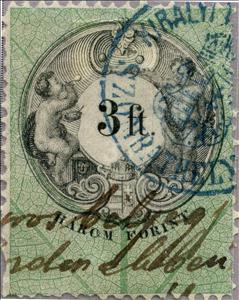Stamp: Numeral and Coat of Arms (Hungary 1870)
Numeral and Coat of Arms (Hungary 1870)
01 January (Hungary ) within release Documentary revenues of Forint/krajczár - Budapest print goes into circulation Stamp Numeral and Coat of Arms face value 3 Hungarian forint
| Stamp Numeral and Coat of Arms in catalogues | |
|---|---|
| Philatelia Hungarica Catalog: | PHu: HU R104b |
Stamp is vertical format.
The line perforation is between 9-11 also mixed with all variants.Also in the issue Documentary revenues of Forint/krajczár - Budapest print:
- Stamp - Numeral and Coat of Arms face value 1;
- Stamp - Numeral and Coat of Arms face value 1;
- Stamp - Numeral and Coat of Arms face value 2;
- Stamp - Numeral and Coat of Arms face value 3;
- Stamp - Numeral and Coat of Arms face value 3;
- Stamp - Numeral and Coat of Arms face value 4;
- Stamp - Numeral and Coat of Arms face value 5;
- Stamp - Numeral and Coat of Arms face value 7;
- Stamp - Numeral and Coat of Arms face value 10;
- Stamp - Numeral and Coat of Arms face value 12;
- Stamp - Numeral and Coat of Arms face value 15;
- Stamp - Numeral and Coat of Arms face value 25;
- Stamp - Numeral and Coat of Arms face value 36;
- Stamp - Numeral and Coat of Arms face value 50;
- Stamp - Numeral and Coat of Arms face value 1;
- Stamp - Numeral and Coat of Arms face value 2;
- Stamp - Numeral and Coat of Arms face value 3;
- Stamp - Numeral and Coat of Arms face value 4;
- Stamp - Numeral and Coat of Arms face value 5;
- Stamp - Numeral and Coat of Arms face value 10;
- Stamp - Numeral and Coat of Arms face value 12;
- Stamp - Numeral and Coat of Arms face value 15;
- Stamp - Numeral and Coat of Arms face value 25;
- Stamp - Numeral and Coat of Arms face value 36;
- Stamp - Numeral and Coat of Arms face value 50;
- Stamp - Numeral and Coat of Arms face value 75;
- Stamp - Numeral and Coat of Arms face value 90;
- Stamp - Numeral and Coat of Arms face value 5;
- Stamp - Numeral and Coat of Arms face value 1;
- Stamp - Numeral and Coat of Arms face value 2;
- Stamp - Numeral and Coat of Arms face value 2.50;
- Stamp - Numeral and Coat of Arms face value 4;
- Stamp - Numeral and Coat of Arms face value 5;
- Stamp - Numeral and Coat of Arms face value 1;
- Stamp - Numeral and Coat of Arms face value 2.50;
- Stamp - Numeral and Coat of Arms face value 3;
- Stamp - Numeral and Coat of Arms face value 4;
- Stamp - Numeral and Coat of Arms face value 6;
- Stamp - Numeral and Coat of Arms face value 7;
- Stamp - Numeral and Coat of Arms face value 10;
- Stamp - Numeral and Coat of Arms face value 15;
- Stamp - Numeral and Coat of Arms face value 20;
Stamp Numeral and Coat of Arms it reflects the thematic directions:
A coat of arms is an heraldic visual design on an escutcheon (i.e. shield), surcoat, or tabard. The coat of arms on an escutcheon forms the central element of the full heraldic achievement which in its whole consists of shield, supporters, crest, and motto. A coat of arms is traditionally unique to an individual person, family (except in the United Kingdom), state, organisation or corporation.
In British heraldry, a coronet is any crown whose bearer is less than sovereign or royal in rank, irrespective of the crown's appearance. In other languages, this distinction is not made, and usually the same word for crown is used irrespective of rank (German: Krone, Dutch: Kroon, Swedish: Krona, French: Couronne, etc.) In this use, the English coronet is a purely technical term for all heraldic images of crowns not used by a sovereign, and implies nothing about the actual shape of the crown depicted. A Coronet is another type of crown, but is reserved for the lower ranks of nobility like Marquesses and Marchionesses, Earls and Countesses, Barons and Baronesses, and some Lords and Ladies. The specific design and attributes of the crown or coronet signifies the hierarchy and ranking of its owner.
A number is a mathematical object used to count, measure, and label. The most basic examples are the natural numbers 1, 2, 3, 4, and so forth. Numbers can be represented in language with number words. More universally, individual numbers can be represented by symbols, called numerals; for example, "5" is a numeral that represents the number five. As only a relatively small number of symbols can be memorized, basic numerals are commonly organized in a numeral system, which is an organized way to represent any number. The most common numeral system is the Hindu–Arabic numeral system, which allows for the representation of any non-negative integer using a combination of ten fundamental numeric symbols, called digits. In addition to their use in counting and measuring, numerals are often used for labels (as with telephone numbers), for ordering (as with serial numbers), and for codes (as with ISBNs). In common usage, a numeral is not clearly distinguished from the number that it represents.



